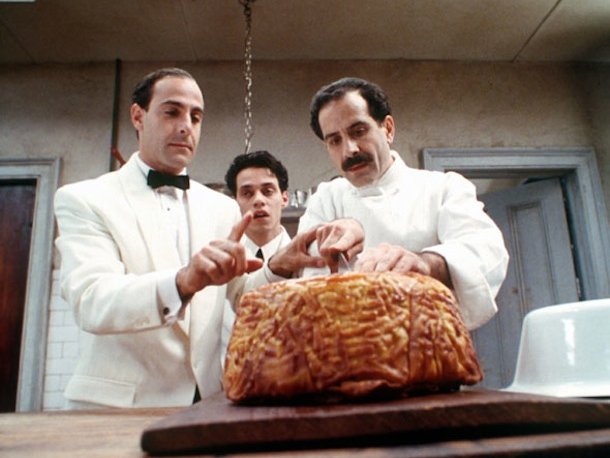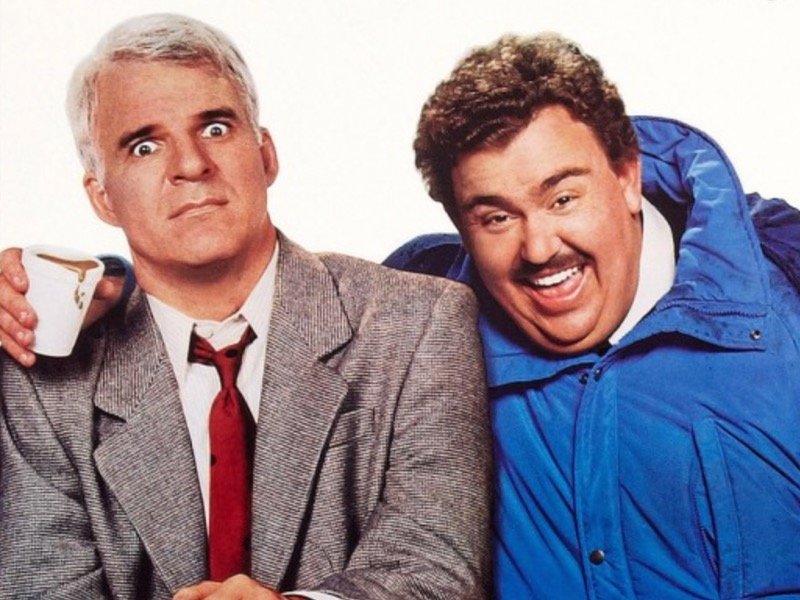"You eat with your eyes."
It’s a famous culinary quote that comes from somebody who didn’t understand how the digestive system works and ended up painfully rubbing a lot of rice pilaf out of his pupils. Or, most likely, comes from a person who knew how addictive merely looking at good food can be. After all, I can watch the Food Network for hours on end, and they’re barely even actually cooking anything on there anymore.
Television may have entire networks and programs dedicated to food, but the title of most memorably tempting foodie bait still belongs to movies. When Hollywood decides to celebrate and showcase food, they make it near impossible to do so without at least a box of Milk Duds nearby to satisfy the cravings. And here are the five most lip-smackingly delicious, foodgasmic examples of cinematic food porn to hit the big screen.
"Big Night"
1996’s "Big Night" is pretty much the "Citizen Kane" of food movies. You can’t talk about the Venn diagram of food and film without "Big Night" being the first thing on the menu. And rightfully so, because the authentic Italian dishes and the movie surrounding them are all quite flavorful.
The movie follows a duo of brothers (house manager Stanley Tucci and ornery chef Tony Shalhoub) as they attempt to keep their restaurant – and their family – afloat in the very competitive world of food. As a result, they arrange a big dinner to hopefully impress a famous jazz singer and spark business. The setpiece of the dinner is also the setpiece of the movie: a timpano, essentially a massive wad of everything delicious in the world baked into a pasta shell.
When they bring it out to the table and start cutting it into slices, co-directors Tucci and Campbell Scott capture each succulent layer of the timpano, as well as everyone at the table amazed by each enrapturing bite. The viewers are stuck just wishing they could join in. It’s the cruelest thing any filmmaker has ever done to an audience (besides "Grown Ups 2").
While the timpano steals the show, it’s the last scene in "Big Night" that brings it home. It’s an almost wordless scene of the brothers cooking up a frittata, putting the table together and enjoying breakfast – and each other’s company – after a night that ended disappointment, anger and failure. It’s a quiet little look into the unifying force of food and family. And of course, the frittata looks great, and the sound design makes it sizzle and sound just terrific as well. The jerks.
"Willy Wonka and the Chocolate Factory"
How many cavities have been caused because of having a sudden hankering for sweets while watching "Willy Wonka and the Chocolate Factory"? If you’re talking to my dentist, the answer would be too many.
The classic Roald Dahl adaptation – which Dahl himself apparently hates – hits on every sweet tooth imaginable, even though in most cases, the candy doesn’t even look real. The chocolate river looks more like dirty water, and that’s definitely not what an everlasting gobstopper is supposed to look like. But the cast members, both young and old, seem so enthusiastic and joyful about the treats that they feel real, and that’s all we need to be convinced. I still to this day want one of those massive gummy bears Wonka knocks off the trees or even merely a Scrumpdiddlyupmtious Bar if I feel like taking it easy on my dentist (which is never).
It’s a true cinematic sugar rush that’s had audiences for decades rushing around for some sugar of their own. Except for that tunnel part. That’s had audiences for decades rushing around for a blanket to cover their eyes with.
"Jiro Dreams of Sushi"
Admission: I’m not much of a sushi guy. So the fact that "Jiro Dreams of Sushi," now available on Netflix Instant, could have even me craving some should speak to its power. David Gelb’s documentary follows Jiro Ono, an 85-year-old sushi master who runs an award-winning, globally renowned restaurant in a Tokyo subway station. The film talks about his tasty techniques, his unique business (it only seats about 10) and his plans of succession. After all, he is in his mid-’80s with two sons lined up as potential protégés.
The real star of the show, though, is the sushi. Each one is a small, simple work of art. There’s nothing particularly fancy about it, but the luscious ingredients and textures of the sushi radiate off the screen, and test your stomach’s ability to last the entire film without ordering some delivery. Plus, seeing the care and consideration each piece of sushi receives from Jiro makes it seem all the more delicious. There’s no grand feast in "Jiro Dreams of Sushi" (it is just sushi after all), but by the end, your eyes will feel stuffed.
"Like Water for Chocolate"
I’m glad "Like Water for Chocolate" exists because, in the future, when somebody asks me what ’90s arthouse cinema was like, I can point to Alfonso Arau’s film and say, "Pretty much that." It’s a pretty silly historical melodrama about Tita, a young woman who’s able to literally cook her feelings into her food. What it’s really about, though, is lush cinematography and steamy hidden passions while music straight out of a cheap telenovela blares on the soundtrack.
If you can choke down the dumb character decisions and the romance novel story, the film’s main course is some really great-looking food. Arau and his cinematographers Steven Bernstein and the great Emmanuel Lubezki (last seen making movie magic in "Gravity") sumptuously capture every delicious ingredient, every dish and every intoxicated reaction. The piece de resistance is a serving of quail and rose petals that looks absolutely sinful. It’s enough to drive one character to a sensory overload. The audience couldn’t agree more.
The rest of "Like Water for Chocolate" is a bit overdone, but the food is cooked to perfection.
"Inglourious Basterds"
Quentin Tarantino’s "Inglourious Basterds" probably isn’t the first thing that pops into mind when you think foodie movies. But, if there’s one thing Quentin Tarantino loves more than bloody, revenge-minded revisionist history, it’s food. And feet. Tarantino also really likes feet.
In between all of the blood spray and profanity, however, QT always makes time for food, and many times, it looks or sounds quite delicious. There was the Big Kahuna burger and the Royale with Cheese in "Pulp Fiction," and more recently, the white cake and those beautiful, foamy amber beers King Schultz serves up to Django in "Django Unchained."
The finest dish, however, is the strudel served up in the middle of an intense face-to-face luncheon between Melanie Laurent and Christoph Waltz in "Inglourious Basterds." The director lingers on every part of the dessert – the crispy layers, the fluffy crème, the way Waltz’s villainously charming Nazi loudly chomps down on every morsel as if rubbing his enjoyment in Laurent and the audience’s face.
Tarantino knows the power of food and a meal between people, and he loves the idea of people taking that power by savoring it in front of others. Somehow, the casual act of ordering a flaky pastry and eating it becomes the ultimate sign of Waltz’s influence and terror over Laurent, as well as one of the most tension-filled sequences in the film. And not just because we all desperately wanted a delectable strudel of our own to enjoy.
As much as it is a gigantic cliché to say that one has always had a passion for film, Matt Mueller has always had a passion for film. Whether it was bringing in the latest movie reviews for his first grade show-and-tell or writing film reviews for the St. Norbert College Times as a high school student, Matt is way too obsessed with movies for his own good.
When he's not writing about the latest blockbuster or talking much too glowingly about "Piranha 3D," Matt can probably be found watching literally any sport (minus cricket) or working at - get this - a local movie theater. Or watching a movie. Yeah, he's probably watching a movie.







